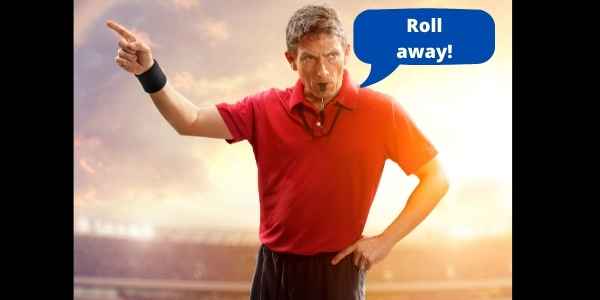When rugby players are tackled, are they allowed to roll forward a few times? Or backward toward their teammates? And what about the tackler?
Like many aspects of rugby, this is a matter of interpretation for the referee. Let’s take a look at when rolling is allowed or not allowed in rugby.
Different Types Of Rolling By The Tackled Player
First, let’s describe what’s going on. I’m not talking about a gymnastic-type forward tumble. In general, you’ll see four types of rolling by the tackled player.
- Momentum roll
- Half roll
- “Man on fire” roll
- Several roles
A momentum roll is a natural outcome of some tackles and is allowed.
A half roll and wriggle in order to place the ball backward is nearly always allowed.
The “man on fire” roll involves rolling forward to disrupt the opposition. Of course, this means that the tackled player is obstructing a contest for the ball. So, this is not allowed!
Disruption is not allowed, but players can try to make this look like a momentum roll!
Finally, what about a player who acts like they’ve been flung from the top of a grassy hill? They repeatedly roll over and over.
No, you don’t see this much outside of underage matches. This is very simple for the referee. Repeated rolling is not allowed!
Now that we’ve summarized the types of rolls by the ball carrier, let’s look at them in more detail.
Momentum Rolls In Rugby

When players are tackled while running at pace, their falling momentum can result in a roll due to force and gravity.
So, they hit the ground on their side but their momentum flips them over onto their back. This kind of momentum roll is allowed in rugby.
Referees will always try to be sympathetic to natural movement like this. Otherwise, the sport would become impossible to play.
Half Rolls To Place The Ball
A half roll is a ninety-degree roll to move from lying on your back or front to lying on your side. This is allowed in rugby. I’ll explain why.
When players are tackled to the ground, the laws say that they must “make the ball available” immediately. They do this through one of these choices:
- place the ball on the ground and take their hands off it i.e. release it.
- pass or “pop” the ball up and backward to a teammate.
- push the ball away in any direction except forward (this means the attacking team lose control so this is rarely done)
Placing the ball is the most common action, but what if the player is on their front or back?
Back to side
What if the momentum of the tackle has ensured that the player has come to a stop on their back?
In this case, it’s accepted that the tackled player can roll 90 degrees from their back to their side in order to place the ball. This is a half roll.
In fact, tackled players should fight hard to roll from their back to their side. They are very vulnerable to being stripped of the ball or having the ball become trapped under a mass of bodies.
Front to side
What if the tackled player lands on their front with the ball beneath them?
The laws say that tackled players mustn’t obstruct the opposition from getting at the ball.
In this situation, they are expected to make a half roll of 90 degrees to get out of the way of the ball.
Man On Fire Roll
A few years ago, we began to see professional players rolling forward for a few revolutions after a tackle. This was seemingly due to momentum.
It looked like the tackler had hit them so hard that they’d been flung forward.
But it soon became clear that defenders had not suddenly started tackling in a new way! It was the tackled players that were doing something different.
Why roll forward when tackled?
There are two advantages to the attacking team if their player rolls forward.
The lesser advantage is that the ball-carrier ekes out an extra meter of territory.
The bigger advantage is from rolling into the legs of the opposition who are trying to compete for the ball. You greatly reduce the chance of the defenders jackling and overturning possession.
But wait, isn’t that illegal? Of course, it is – if it’s interpreted as preventing a fair contest for the ball.
But players tried to make it look like natural momentum made them do it!
Coaching drills
Like many others, I first got wind of what was going on when parents of underage players started chatting about the new technique.
For example, one of the big professional rugby clubs in London ran a summer camp for local kids in 2018.
These twelve and thirteen-year-olds came back to their schools with a new tackling drill. The professional coaches had taught them to roll forward aggressively in the tackle.
World Rugby moves to penalize forward rolls

By late 2018, the top officials in World Rugby decided to remove this technique from the sport. They didn’t need the rewrite the laws. They simply told referees to apply them!
The laws say that the player must release the ball immediately when on the ground.
Although leeway could be given for momentum and a half-roll, referees were told to penalize full rolls into the opposition.
Multiple Rolls After A Tackle
You’ll rarely see a professional player roll over and over on the ground. This is akin to crawling forward for a few yards. It’s simply not allowed (as long as the referee spots it!).
It’s more likely to be seen by beginner players at youth level. The referee will blow the whistle and give a clear explanation as to how the player has infringed.
Rolling To Score A Try
If players are tackled just short of the try line, can they roll in order to score a try? Yes, but only if it’s through natural momentum.
They can’t propel themselves forward on the ground. That would be an infringement with a penalty given. You can read more in our article on double movement in rugby.
But often the players are tackled when at full pelt. They’re allowed to shift their body as momentum (and sometimes wet grass) moves them forward.
To see an example, take a look at the first video in this article on ways to score tries in rugby.
It’s a peach of a team try at international level, as Ireland runs the ball out from their own half.
The final player to touch the ball is tackled from behind, but momentum takes him over the line on his back.
He’s allowed shift and roll to place the ball down for a try.
Tackler, Roll Away!

Up to now, we’ve been talking about the tackled player rolling on the ground.
But one of the more frequent shouts you’ll hear from the referee is: “tackler, roll away!”
When tacklers take the ball carrier to the ground, they must not obstruct the ball or the opposition players.
I was recently watching an international match between Ireland and Spain. It was a qualifier for the Women’s Rugby World Cup.
A Spanish defender tackled an Irish player to the ground. The Irish scrumhalf had to reach over the tackler to try to get at the ball. The referee blew a sharp whistle.
When questioned by the Spanish captain, the referee pointed at the tackler.
“They must roll left or right, not into the nine”.
Referee, Spain vs Ireland, 13 September 2021
I’ll just give one correction to this instruction. The tackler doesn’t just have the option of left or right. They can also roll backwards towards their own side.
Of course, that obstructs other defenders. This is why tackers roll to one side or the other.